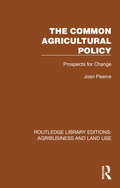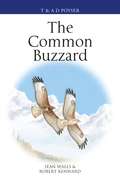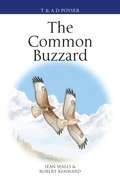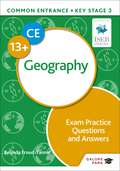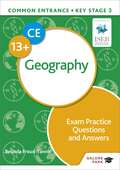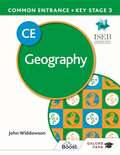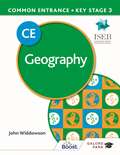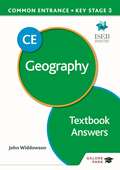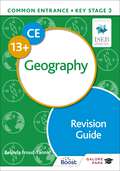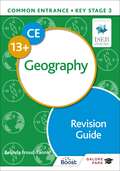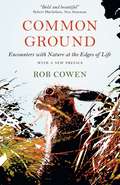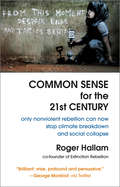- Table View
- List View
The Common Agricultural Policy: Prospects for Change (Routledge Library Editions: Agribusiness and Land Use #20)
by Joan PearceOriginally published in 1981, at a time when the EEC’s Common Agricultural Policy had remained largely unchanged, this book examines the criticisms of the CAP and analyses the pressures emanating from the budget and the various options which were available for tackling them. It then outlines the approaches that individual member states and others were likely to adopt, and assesses whether the need for action on the budget will be used as an opportunity to revise the CAP.
The Common Agricultural Policy: Prospects for Change (Routledge Library Editions: Agribusiness and Land Use #20)
by Joan PearceOriginally published in 1981, at a time when the EEC’s Common Agricultural Policy had remained largely unchanged, this book examines the criticisms of the CAP and analyses the pressures emanating from the budget and the various options which were available for tackling them. It then outlines the approaches that individual member states and others were likely to adopt, and assesses whether the need for action on the budget will be used as an opportunity to revise the CAP.
The Common Agricultural Policy after the Fischler Reform: National Implementations, Impact Assessment and the Agenda for Future Reforms
by Alessandro Sorrentino Roberto HenkeProviding an updated state of the art report on the effects of the 2003 Common Agricultural Policy (CAP) reform, this volume has a particular emphasis on the governance of institutional changes and national/regional implementation. Written from an agricultural economist's point of view and enriched by the contribution of political scientists and policy makers, this book offers: - an updated report of the European debate on agricultural and rural policies; -an in-depth analysis of the decoupling process of the agricultural financial support in Europe; - an analysis of the CAP implementation in the old and new Europe Member States ; - a discussion on the future scenarios for the European Agricultural Policies Based on a selection of papers from the 109th Seminar of the European Association of the Agricultural Economists (EAAE), this book, with a foreword by Franz Fischler, also includes four commissioned contributions from leaders in the field including Sofia Davidova, Roberto Esposti, Tassos Haniotis and Johan Swinnen.
The Common Agricultural Policy after the Fischler Reform: National Implementations, Impact Assessment and the Agenda for Future Reforms
by Alessandro Sorrentino Roberto HenkeProviding an updated state of the art report on the effects of the 2003 Common Agricultural Policy (CAP) reform, this volume has a particular emphasis on the governance of institutional changes and national/regional implementation. Written from an agricultural economist's point of view and enriched by the contribution of political scientists and policy makers, this book offers: - an updated report of the European debate on agricultural and rural policies; -an in-depth analysis of the decoupling process of the agricultural financial support in Europe; - an analysis of the CAP implementation in the old and new Europe Member States ; - a discussion on the future scenarios for the European Agricultural Policies Based on a selection of papers from the 109th Seminar of the European Association of the Agricultural Economists (EAAE), this book, with a foreword by Franz Fischler, also includes four commissioned contributions from leaders in the field including Sofia Davidova, Roberto Esposti, Tassos Haniotis and Johan Swinnen.
The Common Buzzard (Poyser Monographs)
by Sean Walls Robert Kenward'Based on many years of personal research, and a thorough knowledge of the European literature, the authors provide an eminently readable account of the biology of the Common Buzzard. Whatever your interests in birds, I can recommend this book for its content of information and insight.'Professor Ian Newton OBE, FRS, FRSESoaring majestically on thermals with broad wings raised, the Common Buzzard is a familiar sight for many people across Eurasia. In fact, thanks to a remarkable ability to adapt to local conditions, it is now one of the most abundant hawks in the world. The Common Buzzard can exploit a variety of nest sites, and has an eclectic diet that ranges from earthworms and voles to woodpigeons and even deer carcasses. This is a species rich in paradoxes. Why does a hawk evolved for hunting small mammals thrive on invertebrates and carrion? How can a raptor renowned for dramatic territorial displays occur at such high densities? And why does such a large bird that can travel long distances spend so much time in small areas? Sean Walls and Robert Kenward delve deep into the ecology of the Common Buzzard to provide answers to these questions and many more, as well as examining the conservation conundrums raised by this bird. Bringing together a wealth of research on the species' origins, feeding behaviour and breeding, along with information on movement and survival from the authors' own studies, The Common Buzzard provides an invaluable insight into exactly what has enabled this marvellous raptor to return to old haunts to impress, inspire and connect people with nature.
The Common Buzzard (Poyser Monographs)
by Sean Walls Robert Kenward'Based on many years of personal research, and a thorough knowledge of the European literature, the authors provide an eminently readable account of the biology of the Common Buzzard. Whatever your interests in birds, I can recommend this book for its content of information and insight.'Professor Ian Newton OBE, FRS, FRSESoaring majestically on thermals with broad wings raised, the Common Buzzard is a familiar sight for many people across Eurasia. In fact, thanks to a remarkable ability to adapt to local conditions, it is now one of the most abundant hawks in the world. The Common Buzzard can exploit a variety of nest sites, and has an eclectic diet that ranges from earthworms and voles to woodpigeons and even deer carcasses. This is a species rich in paradoxes. Why does a hawk evolved for hunting small mammals thrive on invertebrates and carrion? How can a raptor renowned for dramatic territorial displays occur at such high densities? And why does such a large bird that can travel long distances spend so much time in small areas? Sean Walls and Robert Kenward delve deep into the ecology of the Common Buzzard to provide answers to these questions and many more, as well as examining the conservation conundrums raised by this bird. Bringing together a wealth of research on the species' origins, feeding behaviour and breeding, along with information on movement and survival from the authors' own studies, The Common Buzzard provides an invaluable insight into exactly what has enabled this marvellous raptor to return to old haunts to impress, inspire and connect people with nature.
Common Concern of Humankind im Völkerrecht (Beiträge zum ausländischen öffentlichen Recht und Völkerrecht #289)
by Oliver StrankDieses Buch untersucht die philosophischen Grundlagen und die geschichtliche Entwicklung des common concern of humankind-Begriffs und seine Rechtswirkungen im Völkerrecht. Hierbei wird das Prinzip in den Bestand des Umweltvölkerrechts eingeordnet und sein Verhältnis zum Grundsatz der Staatensouveränität untersucht. Außerdem wird das common concern-Prinzip vom common heritage-Prinzip abgegrenzt und völkerrechtstheoretisch dargelegt, welche Wirkung es als Prinzip innerhalb und außerhalb der von ihm erfassten Regime entfaltet. Der Autor begründet, dass mit der Verankerung des common concern of humankind-Prinzips in der Klimarahmenkonvention und im Pariser Abkommen sowie in der Biodiversitätskonvention die dort enthaltenen Umweltschutzpflichten zu solchen gegenüber der Staatengemeinschaft als Ganzes geworden sind, sodass sich alle Vertragsstaaten - unabhängig von einer eigenen Betroffenheit - gegenüber allen anderen Vertragsstaaten auf ihre Erfüllung berufen können und eine Klagebefugnis vor dem Internationalen Gerichtshof haben.
Common Entrance 13+ Geography Exam Practice Questions and Answers
by Belinda Froud-YannicExam board: ISEB Level: 13+ CE and KS3 Subject: Geography First exam: November 2022Help pupils feel fully prepared for their CE 13+ Geography exams with this extensive ISEB-endorsed exam practice book, aligned to the latest ISEB specification.· Boost confidence with ISEB exam-style questions: practise with a wealth of questions arranged by topic covering all areas of the specification.· Hone exam technique: familiarise pupils with the format and style of questions in the new exam.· Easily mark practice questions: answer guidance has been designed to be clear and easy-to-follow for teachers, parents or tutors marking practice questions, in line with the ISEB mark scheme.· Improve exam results: includes model answers with advice and guidance for achieving top marks.Cover all the topics and skills required for the exam with the Common Entrance 13+ Geography Revision Guide (ISBN: 9781398349674).
Common Entrance 13+ Geography Exam Practice Questions and Answers
by Belinda Froud-YannicExam board: ISEB Level: 13+ CE and KS3 Subject: Geography First exam: November 2022Help pupils feel fully prepared for their CE 13+ Geography exams with this extensive ISEB-endorsed exam practice book, aligned to the latest ISEB specification.· Boost confidence with ISEB exam-style questions: practise with a wealth of questions arranged by topic covering all areas of the specification.· Hone exam technique: familiarise pupils with the format and style of questions in the new exam.· Easily mark practice questions: answer guidance has been designed to be clear and easy-to-follow for teachers, parents or tutors marking practice questions, in line with the ISEB mark scheme.· Improve exam results: includes model answers with advice and guidance for achieving top marks.Cover all the topics and skills required for the exam with the Common Entrance 13+ Geography Revision Guide (ISBN: 9781398349674).
Common Entrance 13+ Geography for ISEB CE and KS3
by John WiddowsonExam board: ISEB Level: 13+ CE and KS3 Subject: Geography First teaching: September 2021 First exams: November 2022Trust John Widdowson and his extensive experience in Common Entrance to guide you through the new ISEB 13+ CE Geography specification so you can help your pupils build confidence, proficiency and a love of Geography with the new Geography series for Common Entrance at 13+ and Key Stage 3.- Support new specification content on the issues tomorrow's geographers will face: A new chapter on the environment looks at local, national and global issues, focusing on sustainability and stewardship (a new addition to the 13+ CE specification for first examination from November 2022).- Push your pupils to achieve the best results: The new 'Your challenge' feature offers additional tasks to stretch pupils.- Cover all the content for human and physical Geography in one book: A more convenient and cost-effective approach for teachers and pupils. - Develop your pupils' investigative skills: An enquiry-based approach encourages pupils to develop their investigative skills.- Guide your pupils to think and work like geographers: The emphasis on geographical skills such as map reading and using sources and resources (for example, interpreting graphs, photos and maps) helps your pupils apply their knowledge.- Beautifully illustrated with engaging visuals: Packed with clear photos, maps and charts to aid learning and recall. Accompanying answers available as a paid-for PDF download at galorepark.co.uk (ISBN: 9781398322127).
Common Entrance 13+ Geography for ISEB CE and KS3
by John WiddowsonExam board: ISEB Level: 13+ CE and KS3 Subject: Geography First teaching: September 2021 First exams: November 2022Trust John Widdowson and his extensive experience in Common Entrance to guide you through the new ISEB 13+ CE Geography specification so you can help your pupils build confidence, proficiency and a love of Geography with the new Geography series for Common Entrance at 13+ and Key Stage 3.- Support new specification content on the issues tomorrow's geographers will face: A new chapter on the environment looks at local, national and global issues, focusing on sustainability and stewardship (a new addition to the 13+ CE specification for first examination from November 2022).- Push your pupils to achieve the best results: The new 'Your challenge' feature offers additional tasks to stretch pupils.- Cover all the content for human and physical Geography in one book: A more convenient and cost-effective approach for teachers and pupils. - Develop your pupils' investigative skills: An enquiry-based approach encourages pupils to develop their investigative skills.- Guide your pupils to think and work like geographers: The emphasis on geographical skills such as map reading and using sources and resources (for example, interpreting graphs, photos and maps) helps your pupils apply their knowledge.- Beautifully illustrated with engaging visuals: Packed with clear photos, maps and charts to aid learning and recall. Accompanying answers available as a paid-for PDF download at galorepark.co.uk (ISBN: 9781398322127).
Common Entrance 13+ Geography for ISEB CE and KS3 Textbook Answers
by John WiddowsonThis PDF download contains full answers to all questions in Common Entrance 13+ Geography for ISEB CE and KS3 (ISBN: 9781398322073).· Answers and indicative content.· Clear layout saves time marking work and allows you to efficiently assess pupils' strengths and weaknesses.· A sample Scheme of Work presents the CE content which must be covered in preparation for CE 13+. It is possible to deliver the content in a number of different ways and we present an option that can be followed or adapted.As a downloadable PDF, please note this resource is non-refundable.
Common Entrance 13+ Geography Revision Guide
by Belinda Froud-YannicExam board: ISEB Level: 13+ CE and KS3 Subject: Geography First exam: November 2022Equip your pupils with the skills and confidence they need to excel in their 13+ CE Geography exams with this comprehensive ISEB-endorsed revision guide.· Revise all topics in the new specification: the guide covers all topics in the new ISEB specification in depth, including a new focus on the environment.· Clear illustrations with engaging visuals: well-annotated illustrations, photos, maps and charts aid learning and recall.· Build confidence ahead of the exam: hone technique with practice of ISEB exam-style questions, with tips and advice along the way.Practise with even more exam-style questions with Common Entrance 13+ Geography Exam Practice Questions and Answers (ISBN: 9781398322103).
Common Entrance 13+ Geography Revision Guide
by Belinda Froud-YannicExam board: ISEB Level: 13+ CE and KS3 Subject: Geography First exam: November 2022Equip your pupils with the skills and confidence they need to excel in their 13+ CE Geography exams with this comprehensive ISEB-endorsed revision guide.· Revise all topics in the new specification: the guide covers all topics in the new ISEB specification in depth, including a new focus on the environment.· Clear illustrations with engaging visuals: well-annotated illustrations, photos, maps and charts aid learning and recall.· Build confidence ahead of the exam: hone technique with practice of ISEB exam-style questions, with tips and advice along the way.Practise with even more exam-style questions with Common Entrance 13+ Geography Exam Practice Questions and Answers (ISBN: 9781398322103).
Common Ground: Encounters with Nature at the Edges of Life
by Rob CowenAll too often, we think of nature as something distinct from ourselves, something to go and see, a place that’s separate from the ordinary modern world in which we live and work. But if we take the time to look, we soon find that’s not how nature works. Even in our parceled-out, paved-over urban environs, nature is all around us; it is in us. It is us. That’s what Rob Cowen discovered after moving to a new home in northern England. After ten years in London he was suddenly adrift, searching for a sense of connection. He found himself drawn to a square-mile patch of waste ground at the edge of town. Scrappy, weed-filled, this heart-shaped tangle of land was the very definition of overlooked—a thoroughly in-between place that capitalism no longer had any use for, leaving nature to take its course. Wandering its meadows, woods, hedges, and fields, Cowen found it was also a magical, mysterious place, haunted and haunting, abandoned but wildly alive—and he fell in fascinated love. Common Ground is a true account of that place and Cowen’s transformative journey through its layers and lives, but it’s much more too. As the land’s stories intertwine with events in his own life—and he learns he is to become a father for the first time—the divisions between human and nature begin to blur and shift. The place turns out to be a mirror, revealing what we are, what we’re not and how those two things are ultimately inseparable. This is a book about discovering a new world, a forgotten world on the fringes of our daily lives, and the richness that comes from uncovering the stories and lives—animal and human—contained within. It is an unforgettable piece of nature writing, part of a brilliant tradition that stretches from Gilbert White to Robert Macfarlane and Helen Macdonald. “I am dreaming of the edge-land again,” Cowen writes. Read Common Ground, and you, too, will be dreaming of the spaces in between, and what—including us—thrives there.
Common Ground: Encounters with Nature at the Edges of Life
by Rob CowenAll too often, we think of nature as something distinct from ourselves, something to go and see, a place that’s separate from the ordinary modern world in which we live and work. But if we take the time to look, we soon find that’s not how nature works. Even in our parceled-out, paved-over urban environs, nature is all around us; it is in us. It is us. That’s what Rob Cowen discovered after moving to a new home in northern England. After ten years in London he was suddenly adrift, searching for a sense of connection. He found himself drawn to a square-mile patch of waste ground at the edge of town. Scrappy, weed-filled, this heart-shaped tangle of land was the very definition of overlooked—a thoroughly in-between place that capitalism no longer had any use for, leaving nature to take its course. Wandering its meadows, woods, hedges, and fields, Cowen found it was also a magical, mysterious place, haunted and haunting, abandoned but wildly alive—and he fell in fascinated love. Common Ground is a true account of that place and Cowen’s transformative journey through its layers and lives, but it’s much more too. As the land’s stories intertwine with events in his own life—and he learns he is to become a father for the first time—the divisions between human and nature begin to blur and shift. The place turns out to be a mirror, revealing what we are, what we’re not and how those two things are ultimately inseparable. This is a book about discovering a new world, a forgotten world on the fringes of our daily lives, and the richness that comes from uncovering the stories and lives—animal and human—contained within. It is an unforgettable piece of nature writing, part of a brilliant tradition that stretches from Gilbert White to Robert Macfarlane and Helen Macdonald. “I am dreaming of the edge-land again,” Cowen writes. Read Common Ground, and you, too, will be dreaming of the spaces in between, and what—including us—thrives there.
Common Ground: Encounters with Nature at the Edges of Life
by Rob CowenAll too often, we think of nature as something distinct from ourselves, something to go and see, a place that’s separate from the ordinary modern world in which we live and work. But if we take the time to look, we soon find that’s not how nature works. Even in our parceled-out, paved-over urban environs, nature is all around us; it is in us. It is us. That’s what Rob Cowen discovered after moving to a new home in northern England. After ten years in London he was suddenly adrift, searching for a sense of connection. He found himself drawn to a square-mile patch of waste ground at the edge of town. Scrappy, weed-filled, this heart-shaped tangle of land was the very definition of overlooked—a thoroughly in-between place that capitalism no longer had any use for, leaving nature to take its course. Wandering its meadows, woods, hedges, and fields, Cowen found it was also a magical, mysterious place, haunted and haunting, abandoned but wildly alive—and he fell in fascinated love. Common Ground is a true account of that place and Cowen’s transformative journey through its layers and lives, but it’s much more too. As the land’s stories intertwine with events in his own life—and he learns he is to become a father for the first time—the divisions between human and nature begin to blur and shift. The place turns out to be a mirror, revealing what we are, what we’re not and how those two things are ultimately inseparable. This is a book about discovering a new world, a forgotten world on the fringes of our daily lives, and the richness that comes from uncovering the stories and lives—animal and human—contained within. It is an unforgettable piece of nature writing, part of a brilliant tradition that stretches from Gilbert White to Robert Macfarlane and Helen Macdonald. “I am dreaming of the edge-land again,” Cowen writes. Read Common Ground, and you, too, will be dreaming of the spaces in between, and what—including us—thrives there.
Common Ground: Encounters with Nature at the Edges of Life
by Rob CowenAll too often, we think of nature as something distinct from ourselves, something to go and see, a place that’s separate from the ordinary modern world in which we live and work. But if we take the time to look, we soon find that’s not how nature works. Even in our parceled-out, paved-over urban environs, nature is all around us; it is in us. It is us. That’s what Rob Cowen discovered after moving to a new home in northern England. After ten years in London he was suddenly adrift, searching for a sense of connection. He found himself drawn to a square-mile patch of waste ground at the edge of town. Scrappy, weed-filled, this heart-shaped tangle of land was the very definition of overlooked—a thoroughly in-between place that capitalism no longer had any use for, leaving nature to take its course. Wandering its meadows, woods, hedges, and fields, Cowen found it was also a magical, mysterious place, haunted and haunting, abandoned but wildly alive—and he fell in fascinated love. Common Ground is a true account of that place and Cowen’s transformative journey through its layers and lives, but it’s much more too. As the land’s stories intertwine with events in his own life—and he learns he is to become a father for the first time—the divisions between human and nature begin to blur and shift. The place turns out to be a mirror, revealing what we are, what we’re not and how those two things are ultimately inseparable. This is a book about discovering a new world, a forgotten world on the fringes of our daily lives, and the richness that comes from uncovering the stories and lives—animal and human—contained within. It is an unforgettable piece of nature writing, part of a brilliant tradition that stretches from Gilbert White to Robert Macfarlane and Helen Macdonald. “I am dreaming of the edge-land again,” Cowen writes. Read Common Ground, and you, too, will be dreaming of the spaces in between, and what—including us—thrives there.
Common hair cap moss (large print)
by RnibThis is an image of a Common Hair-cap Moss (Polytrichum commune) sporophyte. This has grown from a zygote, the result of the fusing of male and female gametes on the green plant (gametophyte). The sporophyte remains attached to the green plant.There is a locator dot shown, which will be at the top left of the page when the image is the correct way up.The moss is fixed in the ground at the bottom centre of the page. Going up from here there are narrow leaves growing out to the left and right from the stem. There are brown leaves at the bottom and green leaves further up.The stem continues up the page.You will find the plans capsule containing spores at the top of the image. It has a lid, with beak on top, which opens to release the spores; these will grow into new green plants.Like most mosses the Hair-cap grows in moist habitats: wet heathland or bogs. Its height ranges from 5 to 30 centimetres. Many plants will grow together to form a thick mat.
Common hair cap moss (UEB contracted)
by RnibThis is an image of a Common Hair-cap Moss (Polytrichum commune) sporophyte. This has grown from a zygote, the result of the fusing of male and female gametes on the green plant (gametophyte). The sporophyte remains attached to the green plant.There is a locator dot shown, which will be at the top left of the page when the image is the correct way up.The moss is fixed in the ground at the bottom centre of the page. Going up from here there are narrow leaves growing out to the left and right from the stem. There are brown leaves at the bottom and green leaves further up.The stem continues up the page.You will find the plans capsule containing spores at the top of the image. It has a lid, with beak on top, which opens to release the spores; these will grow into new green plants.Like most mosses the Hair-cap grows in moist habitats: wet heathland or bogs. Its height ranges from 5 to 30 centimetres. Many plants will grow together to form a thick mat.
Common hair cap moss (UEB uncontracted)
by RnibThis is an image of a Common Hair-cap Moss (Polytrichum commune) sporophyte. This has grown from a zygote, the result of the fusing of male and female gametes on the green plant (gametophyte). The sporophyte remains attached to the green plant.There is a locator dot shown, which will be at the top left of the page when the image is the correct way up.The moss is fixed in the ground at the bottom centre of the page. Going up from here there are narrow leaves growing out to the left and right from the stem. There are brown leaves at the bottom and green leaves further up.The stem continues up the page.You will find the plans capsule containing spores at the top of the image. It has a lid, with beak on top, which opens to release the spores; these will grow into new green plants.Like most mosses the Hair-cap grows in moist habitats: wet heathland or bogs. Its height ranges from 5 to 30 centimetres. Many plants will grow together to form a thick mat.
The Common Lands of England and Wales (Collins New Naturalist Library #45)
by W. G. Hoskins L. Dudley StampAll common lands and village greens are listed county by county, along with an analysis of their legal and natural state. This edition is produced from an original copy by William Collins.
The Common Place: The Ordinary Experience of Housing
by Peter KingMuch of what constitutes our experience of our immediate environment is quite ordinary and familiar, in particular, where we live. While policymakers and academics are constantly seeking transformations in housing, what we seek from our own housing is stability and lack of change. We seek secure roots to our lives rather than step-changes and radical reform. This book considers this ordinary experience of housing and how we come to depend upon it. The notion of the ordinary is used to argue against the conceits of policymaking and the fetish for domestic design. Using a variety of methods such as critical analysis and film criticism (looking at the work of film-makers as diverse as Bergman, Dreyer, Shyamalan, Tarkovsky, Tati and the Wachowski Brothers), it provides an original, impressionistic view of the role housing plays in our lives.
The Common Place: The Ordinary Experience of Housing
by Peter KingMuch of what constitutes our experience of our immediate environment is quite ordinary and familiar, in particular, where we live. While policymakers and academics are constantly seeking transformations in housing, what we seek from our own housing is stability and lack of change. We seek secure roots to our lives rather than step-changes and radical reform. This book considers this ordinary experience of housing and how we come to depend upon it. The notion of the ordinary is used to argue against the conceits of policymaking and the fetish for domestic design. Using a variety of methods such as critical analysis and film criticism (looking at the work of film-makers as diverse as Bergman, Dreyer, Shyamalan, Tarkovsky, Tati and the Wachowski Brothers), it provides an original, impressionistic view of the role housing plays in our lives.
Common Sense for the 21st Century: Only Nonviolent Rebellion Can Now Stop Climate Breakdown and Social Collapse
by Roger Hallam“Brilliant, wise, profound and persuasive. Common Sense for the 21st Century will come to be recognized as a classic of political theory.”—George Monbiot, via Twitter An urgent, essential, and practical call to action from a cofounder of Extinction Rebellion What can we all do to avert catastrophe and avoid extinction? Roger Hallam has answers. In Common Sense for the 21st Century, Roger Hallam, cofounder of Extinction Rebellion, outlines how movements around the world need to come together now to start doing what works: engaging in mass civil disobedience to make real change happen. The book gives people the tools to understand not only why mass disruption, mass arrests, and mass sacrifice are necessary but also details how to carry out acts of civil disobedience effectively, respectfully and nonviolently. It bypasses contemporary political theory, and instead is inspired by Thomas Paine, the pragmatic 18th-century revolutionary whose pamphlet Common Sense sparked the American Revolution. Common Sense for the 21st Century urges us to confront the truth about climate change and argues forcefully that only a revolution of society and the state, similar to the turn that Paine urged the Americans to take into the political unknown, can save us now.
